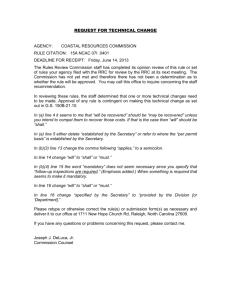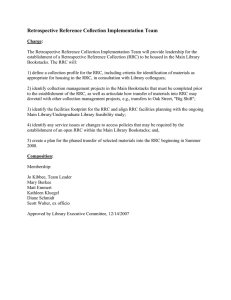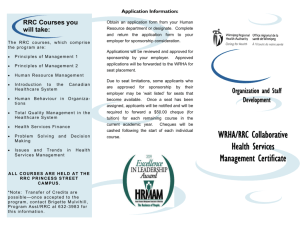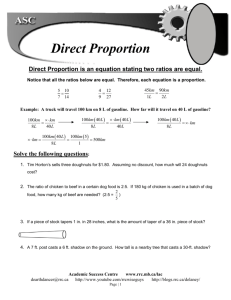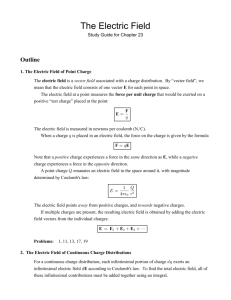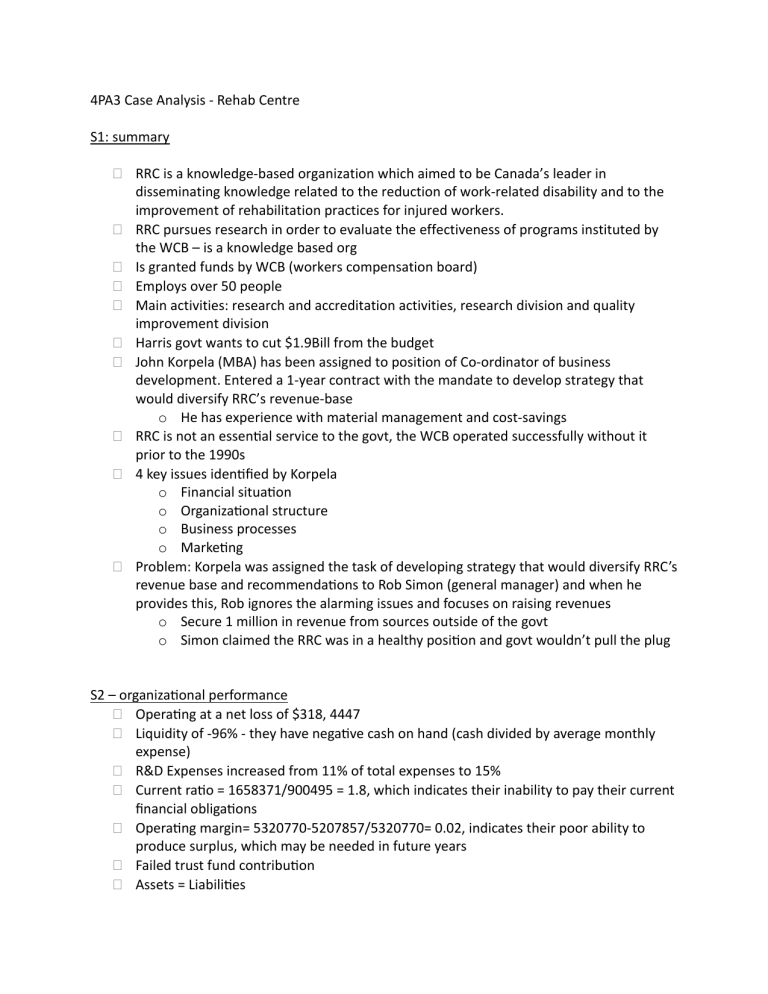
4PA3 Case Analysis - Rehab Centre S1: summary • • • • • • • • • • RRC is a knowledge-based organization which aimed to be Canada’s leader in disseminating knowledge related to the reduction of work-related disability and to the improvement of rehabilitation practices for injured workers. RRC pursues research in order to evaluate the effectiveness of programs instituted by the WCB – is a knowledge based org Is granted funds by WCB (workers compensation board) Employs over 50 people Main activities: research and accreditation activities, research division and quality improvement division Harris govt wants to cut $1.9Bill from the budget John Korpela (MBA) has been assigned to position of Co-ordinator of business development. Entered a 1-year contract with the mandate to develop strategy that would diversify RRC’s revenue-base o He has experience with material management and cost-savings RRC is not an essenXal service to the govt, the WCB operated successfully without it prior to the 1990s 4 key issues idenXfied by Korpela o Financial situaXon o OrganizaXonal structure o Business processes o MarkeXng Problem: Korpela was assigned the task of developing strategy that would diversify RRC’s revenue base and recommendaXons to Rob Simon (general manager) and when he provides this, Rob ignores the alarming issues and focuses on raising revenues o Secure 1 million in revenue from sources outside of the govt o Simon claimed the RRC was in a healthy posiXon and govt wouldn’t pull the plug S2 – organizaXonal performance • OperaXng at a net loss of $318, 4447 • Liquidity of -96% - they have negaXve cash on hand (cash divided by average monthly expense) • R&D Expenses increased from 11% of total expenses to 15% • Current raXo = 1658371/900495 = 1.8, which indicates their inability to pay their current financial obligaXons • OperaXng margin= 5320770-5207857/5320770= 0.02, indicates their poor ability to produce surplus, which may be needed in future years • Failed trust fund contribuXon • Assets = LiabiliXes S3- OrganizaXonal health – raXng of 2 • Employees are concerned about cuts to the organizaXon, which is affecXng their daily performance • Lack of professional managerial training • Lack of communicaXon across departments and research teams • No formalized business process – no clear direcXon, which can increase costs and slow the advancement of projects S6 – Goals Rob’s goals • • • • secure $1 million in revenue from sources outside the government Commercializing outcomes-focused accreditations Commercializing an assessment instrument for upper-extremity injuries Commercializing back guidelines training software Korpela’s goals • • • • • • Start acting as independent educator for the industry Secure contracts with large private manufacturers where disability insurance is concern Do what they’re doing internationally; consulting Provide educational services to universities or health associations Move into developing rehabilitation software Soft goals; re-organize company structure, make teams bond, get rid of Rob S8 – Value proposiXon • Its primary focus is on features; specializing in advanced knowledge research which gives them ability to give credibility to rehabilitation centres. “A knowledge-based organization which aims to be Canada’s leader in disseminating knowledge related to reduction of work-related disability and to improvement of rehab practices for injured workers • it’s competing on execution in terms of having the ability to evaluate a rehab centre’s programs and offer accreditation E15 – Business Model • Revenues: from the funding they receive (currently about 92% comes from WCB), additional sources, and interest revenue, contract work from Ontario insurance commission and other private organizations • • • • Expenses include salary, program development, services of research consultants and related costs, rent, office, meetings and conferences, etc. In 1994, they make a contribution to a trust fund for 400k which is major reason they had negative profit Research department is a cost centre due to its limited ability to generate revenue Quality improvement is the profit centre as it generated revenue from accrediXng rehab clinics in the province 22– AlternaXves 1. Pulling the plug a. Harris’ confidence grew in slashing other programs 2. PrivaXzaXon a. government were to privatize the WCB, companies would be required to buy workers’ compensation insurance privately and the activities of the WCB would pass to the private sector. The RRC, by virtue of its relationship with the WCB, would continue to operate under its umbrella as a private research institution. 3. Value for money audit a. WCB and other government agencies were in line to be put through valuefor-money audits. b. judged to see if the WCB would be better off (financially or operationally) with or without that service. c. RRC would probably be evaluated as not providing enough added-value for the WCB 4. University collaboraXon a. Universities, with the competitive advantage of economies of scale and scope, as well as brand equity, were formidable competitors for the RRC. However, the intellectual capital at RRC was an attractive asset. Universities could perhaps collaborate or even acquire the RRC in the future as a satellite operation. 5. Independent business a. RRC could diversify its revenue stream by securing research contracts with large private institutions such as General Motors, Ford and TorStar. Many of these organizations were very interested in the research that the RRC had conducted (especially their expertise in back pain). These organizations would be willing to fund research in this area if the recommendations for prevention also became their property. Furthermore, the RRC would have to demonstrate material benefit for these companies (i.e., lower labour costs due to decreased disability).

